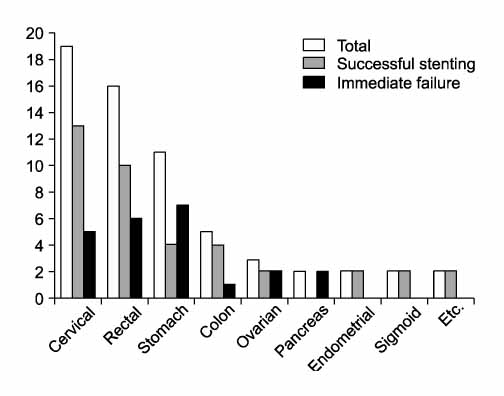Korean J Urol.
2008 Jan;49(1):49-54.
The Clinical Characteristics of Malignant Ureteral Obstruction Secondary to Non-genitourinary Malignancy
- Affiliations
-
- 1Department of Urology, Wonkwang University School of Medicine, Institute of Wonkwang Medical Science, Iksan, Korea. sc.park@ wonkwang.ac.kr
Abstract
-
PURPOSE: We assessed the success rate of internal ureteral stenting and the complications for patients with ureteral obstruction secondary to non-genitourinary malignancy.
MATERIALS AND METHODS
Between January 2001 and December 2005, ureteral stenting were attempted in 62 patients with ureteral obstruction secondary to non-genitourinary malignancy. Their medical records were reviewed for the primary diagnosis, the symptoms, the degree of hydronephrosis, the location of obstruction, stent failure, the time period until stent replacement due to stent failure, the complications and the status at the last followup.
RESULTS
A total 62 patients underwent an attempt at retrograde ureteral stenting for malignant extrinsic obstruction. The mean patient age was 57.6 years(range: 32-84) and the mean follow-up was 12.6 months. 44 patients(71%) were women, and the most common cancer diagnoses were cervical cancer(19), rectal cancer(16) and stomach cancer(11). A total of 23 patients(37%) required immediate percutaneous nephrostomy(PCN) referral. A total of 14 patients experienced late failure and required PCN. A total of 39 patients underwent stent replacement at a mean interval of 3.5 months.
CONCLUSIONS
At almost 1 year follow-up, stent failure due to extrinsic compression occurred in 55.7% of the patients(37 of 62). We should carefully monitor patient who undergo ureteral stenting for ongoing obstruction and complication.
MeSH Terms
Figure
Reference
-
1. Chung SY, Stein RJ, Landsittel D, Davies BJ, Cuellar DC, Hrebinko RL, et al. 15-year experience with the management of extrinsic ureteral obstruction with indwelling ureteral stents. J Urol. 2004. 172:592–595.2. Donat SM, Russo P. Ureteral decompression in advanced nonurologic malignancies. Ann Surg Oncol. 1996. 3:393–399.3. Emmert C, Rassler J, Kohler U. Survival and quality of life after percutaneous nephrostomy for malignant ureteric obstruction in patients with terminal cervical cancer. Arch Gynecol Obstet. 1997. 259:147–151.4. Harrington KJ, Pandha HS, Kelly SA, Lambert HE, Jackson JE, Waxman J. Palliation of obstructive nephropathy due to malignancy. Br J Urol. 1995. 76:101–107.5. Russo P. Urologic emergencies in the cancer patient. Semin Oncol. 2000. 27:284–298.6. Feng MI, Bellman GC, Shapiro CE. Management of ureteral obstruction secondary to pelvic malignancies. J Endourol. 1999. 13:521–524.7. Docimo SG, Dewolf WC. High failure rate of indwelling ureteral stents in patients with extrinsic obstruction: experience at 2 institutions. J Urol. 1989. 142:277–279.8. Ku JH, Lee SW, Jeon HG, Kim HH, Oh SJ. Percutaneous nephrostomy versus indwelling ureteral stents in the management of extrinsic ureteral obstruction in advanced malignancies: are there differences? Urology. 2004. 64:895–899.9. Joshi HB, Adams S, Obadeyi OO, Rao PN. Nephrostomy tube or 'JJ' ureteric stent in ureteric obstruction: assessment of patient perspectives using quality-of-life survey and utility analysis. Eur Urol. 2001. 39:695–701.10. Hoe JW, Tung KH, Tan EC. Re-evaluation of indications for percutaneous nephrostomy and interventional uroradiological procedures in pelvic malignancy. Br J Urol. 1993. 71:469–472.11. Chapman ME, Reid JH. Use of percutaneous nephrostomy in malignant ureteric obstruction. Br J Radiol. 1991. 64:318–320.12. Teenan RP, Ramsay A, Deane RF. Percutaneous nephrostomy in the management of malignant ureteric obstruction. Br J Urol. 1989. 64:238–240.13. Dudley BS, Gershenson DM, Kavanagh JJ, Copeland LJ, Carrasco CH, Rutledge FN. Percutaneous nephrostomy catheter use in gynecologic malignancy: M.D. Anderson Hospital experience. Gynecol Oncol. 1986. 24:273–278.14. Chitale SV, Scott-Barrett S, Ho ET, Burgess NA. The management of ureteric obstruction secondary to malignant pelvic disease. Clin Radiol. 2002. 57:1118–1121.15. Park DS, Park JH, Lee YT. Percutaneous nephrostomy versus indwelling ureteral stents in patients with bilateral nongenitourinary malignant extrinsic obstruction. J Endourol. 2002. 16:153–154.16. Hyppolite JC, Daniels ID, Friedman EA. Obstructive uropathy in gynecologic malignancy. Detrimental effect of intraureteral stent placement and value of percutaneous nephrostomy. ASAIO J. 1995. 41:M318–M323.17. Feuer GA, Fruchter R, Seruri E, Maiman M, Remy JC, Boyce JG. Selection for percutaneous nephrostomy in gynecologic cancer patients. Gynecol Oncol. 1991. 42:60–63.18. Gibbons RP, Correa RJ Jr, Cummings KB, Mason JT. Experience with indwelling ureteral stent catheters. J Urol. 1976. 115:22–26.19. Finney RP. Experience with new double J ureteral chateter stent. J Urol. 1978. 120:678–681.20. Hepperlen TW, Mardis HK, Kammandel H. Self-retained internal ureteral stents: a new approach. J Urol. 1978. 119:731–734.21. Gibbons RP. Gibbons ureteral stents. Urol Clin North Am. 1982. 9:85–88.22. Hepperlen TW, Mardis HK, Kammandel H. The pigtail ureteral stent in the cancer patient. J Urol. 1979. 121:17–18.23. Andriole GL, Bettmann MA, Garnick MB, Richie JP. Indwelling double-J ureteral stents for temporary and permanent urinary drainage: experience with 87 patients. J Urol. 1984. 131:239–241.24. Finney RP. Double-J and diversion stents. Urol Clin North Am. 1982. 9:89–94.25. Docimo SG, Dewolf W. High failure rate of indwelling ureteral stents in patients with extrinsic obstruction: experience at 2 institutions. J Urol. 1989. 142:277–279.26. Schlick RW, Seidle EM, Kalem T, Valkmer B, Planz K. New endoureteral double-J stent resists extrinsic ureteral compression. J Endourol. 1998. 12:37–40.27. Tligui M, Nouri M, You R, Haab F, Gattegno B, Thibault P. Value of cloverleaf double J ureteral stent in the treatment of extrinsic ureteral compression. Prog Urol. 2000. 10:92–94.28. Liu JS, Hrebinko RL. The use of 2 ipsilateral ureteral stents for relief of ureteral obstruction from extrinsic compression. J Urol. 1998. 159:179–181.29. Hamm M, Rathert P. Therapy of extrinsic ureteral obstruction by 2 parallel double-J ureteral stents. Urologe A. 1999. 38:150–155.30. Duvdevani M, Chew BH, Denstedt JD. Minimizing symptoms in patients with ureteric stents. Curr Opin Urol. 2006. 16:77–82.
- Full Text Links
- Actions
-
Cited
- CITED
-
- Close
- Share
- Similar articles
-
- Percutaneous Nephrostomy in Patients with Ureteral Obstruction Secondary to Pelvic Tumor
- A Case of Endometriosis of the Ureter
- Percutaneous nephrostomy in the patients with ureteral obstruction by tumor
- Antegrade Ureteral Stenting in Ureteral Obstruction
- Malignant Ureteral Obstruction secondary to Stomach Cancer



